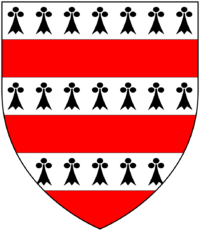Thomas Hungerford (speaker) facts for kids
Sir Thomas de Hungerford (who died on December 3, 1397) was an important figure in England. He lived at Farleigh Castle in Somerset. He was the first person officially written down in the records of the Parliament of England as the "Speaker" of the House of Commons of England. This job existed before him, but he was the first to be formally named.
Contents
Who Was Sir Thomas Hungerford?
Sir Thomas Hungerford was the son of Walter de Hungerford. His father was a Member of Parliament (MP) for Wiltshire three times. His mother was Elizabeth FitzJohn. Her family came from Cherhill in Wiltshire. The Hungerford family had lived in Wiltshire since the 1100s.
His Uncle
Sir Thomas had an uncle named Robert Hungerford (who died in 1355). Robert was also a Member of Parliament for Wiltshire. He gave land to a hospital and churches. He was buried in Hungerford Church.
Sir Thomas's Career
Sir Thomas Hungerford had a busy career in public service. He was the Sheriff of Wiltshire from 1355 to 1360. A sheriff was like a chief law enforcement officer for a county. He also served many times as a Member of Parliament for Wiltshire and Somerset. He became a knight in February 1375.
He worked closely with John of Gaunt, a very powerful duke. Sir Thomas was even the manager of Gaunt's household for a while.
Becoming Speaker of the House
Because of John of Gaunt's influence, Sir Thomas was chosen as the Speaker of the House of Commons in January 1377. This happened during the last parliament of King Edward III. The records say that Hungerford "spoke for the common people of England in this Parliament." This makes him the first person officially named as the Speaker in the Parliament's records. Another person, Sir Peter de la Mare, had done the job before him, but without the official title.
Farleigh Castle
In 1380, Sir Thomas became the Forester of Selwood, which meant he managed the royal forest. In 1369, he bought a large estate called Farleigh Montfort. Today, it is known as Farleigh Hungerford. This place became the main home for his family for many years. In 1383, he got permission to build walls and towers around his home. This turned his manor house into Farleigh Castle.
Around 1384, King Richard II became suspicious of Sir Thomas. The King tried to seize his property. But Sir Thomas was able to get a pardon from the King. He also got permission to keep his hunting rights at Farleigh.
Family Life
Sir Thomas Hungerford was married two times:
- His first wife was Eleanor Strug.
- His second wife was Joan Hussey (who died in 1412). With Joan, he had one son who lived to adulthood:
- Walter Hungerford, 1st Baron Hungerford (who died in 1449). Walter became a very important person himself.
Death and Burial
Sir Thomas Hungerford passed away at Farleigh on December 3, 1397. He was buried at Farleigh Hungerford Castle. You can still see his tomb there, with statues of him and his wife. There was also a picture of him in a stained-glass window.





